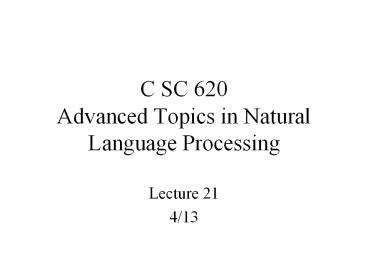C SC 620 Advanced Topics in Natural Language Processing - PowerPoint PPT Presentation
Title:
C SC 620 Advanced Topics in Natural Language Processing
Description:
C SC 620 Advanced Topics in Natural Language Processing Lecture 21 4/13 – PowerPoint PPT presentation
Number of Views:84
Avg rating:3.0/5.0
Title: C SC 620 Advanced Topics in Natural Language Processing
1
C SC 620Advanced Topics in Natural Language
Processing
- Lecture 21
- 4/13
2
Reading List
- Readings in Machine Translation, Eds. Nirenburg,
S. et al. MIT Press 2003. - 19. Montague Grammar and Machine Translation.
Landsbergen, J. - 20. Dialogue Translation vs. Text Translation
Interpretation Based Approach. Tsujii, J.-I. And
M. Nagao - 21. Translation by Structural Correspondences.
Kaplan, R. et al. - 22. Pros and Cons of the Pivot and Transfer
Approaches in Multilingual Machine Translation.
Boitet, C. - 31. A Framework of a Mechanical Translation
between Japanese and English by Analogy
Principle. Nagao, M. - 32. A Statistical Approach to Machine
Translation. Brown, P. F. et al.
3
(No Transcript)
4
Phraselator
DARPA.asf
5
(No Transcript)
6
Paper 20. Dialogue Translation vs. Text
Translation Interpretation Based Approach.
Tsujii, J.-I. And M. Nagao
- Time Late-80s
- Dialogue translation differs from document
translation - Argues that the goal oriented nature of dialogues
makes translation more feasible than textual
translation
7
Paper 20. Dialogue Translation vs. Text
Translation Interpretation Based Approach.
Tsujii, J.-I. And M. Nagao
- Differences of Environments
- Example of dialogues
- hotel reservation, conference registration,
doctor-patient - Clear definition of information
- Active participation of speakers and hearers
- Writers and readers unavailable during
translation - What Should be Translated?
- Dialogues (usually) have a purpose
- Can define what is important and what is not
8
Paper 20. Dialogue Translation vs. Text
Translation Interpretation Based Approach.
Tsujii, J.-I. And M. Nagao
- What Should be Translated?
- Example
- Japanese hotel-topic, friends-with disco-to
want-to-because, Roppongi-gen be-near-nom is-good - SBT As for hotel, because I would like to go to
Disco with friends, to be near to Roppongi is
good - English Translation Because Id like to go to
disco with friends, I prefer to stay at a hotel
in Roppongi - SBT Structure Bound Translation
- Prefer and stay not in source utterance
9
Paper 20. Dialogue Translation vs. Text
Translation Interpretation Based Approach.
Tsujii, J.-I. And M. Nagao
- Architecture of Dialogue Translation Systems
- Extract important information from source
utterances
10
Paper 20. Dialogue Translation vs. Text
Translation Interpretation Based Approach.
Tsujii, J.-I. And M. Nagao
- Examples
- J Roppongi-gen be-near-gen hotel-nom good is
- SBT A hotel near to Roppongi is good
- J Roppongi-around-gen hotel-acc please
- SBT A hotel around Roppongi, please
- J Hotel-topic roppingi-no be-near-nom good is
- SBT As for hotel, to be near to Roppongi is
good - J be-convenient-topic roppongi-to near hotel is
- SBT What is convenient is a hotel near to
Roppongi
11
Paper 20. Dialogue Translation vs. Text
Translation Interpretation Based Approach.
Tsujii, J.-I. And M. Nagao
- Dialogue translation system need not understand
utterances completely, just the important bits - Need not translate fluently the unimportant bits
- Real world knowledge
- Roppongi is a special region in Tokyo where many
discos exist - In order to go to some place, it is preferable to
stay at a hotel near to the place
12
Paper 20. Dialogue Translation vs. Text
Translation Interpretation Based Approach.
Tsujii, J.-I. And M. Nagao
- Active Participation of Speakers and Hearers
- Translation of dialogues allows for questions
from user when translation does not supply
necessary information or when translation cannot
be understood - Also permits system to ask clarification
questions - Example
- E In which region do you want to stay in Tokyo?
- J Disco-to want-to-go
- System The question is in which region do you
want to stay in Tokyo? Would you specify the
place which you prefer to stay?
13
Paper 21. Translation by Structural
Correspondences. Kaplan, R. et al.
- Lexical-Functional Grammar (LFG)
- Claim Modularity
- Modularity of linguistic specifications
- Not a single level that connects two languages
- Instead, simultaneous correspondences
- Permits contrastive transfer rules that depend on
but do not duplicate the specifications of
independently motivated grammars of source and
target languages
14
Paper 21. Translation by Structural
Correspondences. Kaplan, R. et al.
- A General Architecture for Linguistic
Descriptions - LFG
- c-structure (constituent)
- f-structure (grammatical function)
15
Paper 21. Translation by Structural
Correspondences. Kaplan, R. et al.
- A General Architecture for Linguistic
Descriptions - LFG
- c-structure (constituent)
- f-structure (grammatical function)
- Semantic structure
16
Paper 21. Translation by Structural
Correspondences. Kaplan, R. et al.
- Examples
- Change in grammatical function
- (German) Der Student beantwortet die Frage
- (French) Létudiant répond à la question
- Transitive verb in German, intransitive verb with
an oblique complement in French
17
Paper 21. Translation by Structural
Correspondences. Kaplan, R. et al.
18
Paper 21. Translation by Structural
Correspondences. Kaplan, R. et al.
19
Paper 21. Translation by Structural
Correspondences. Kaplan, R. et al.
- Example
- Differences in control
- The student is likely to work
- It est probable que létudiant travaillera
- Infinitival complement of a raising verb is
translated into a finite clause
20
Paper 21. Translation by Structural
Correspondences. Kaplan, R. et al.
21
Paper 21. Translation by Structural
Correspondences. Kaplan, R. et al.
- Differences in Embedding
- The baby just fell
- Le bébé vient de tomber
22
Paper 21. Translation by Structural
Correspondences. Kaplan, R. et al.
f-structure for S
f-structure for ADV
23
Paper 21. Translation by Structural
Correspondences. Kaplan, R. et al.































